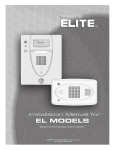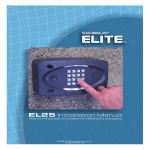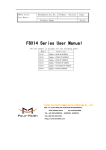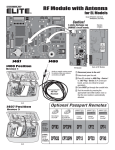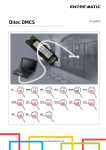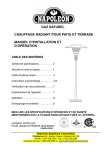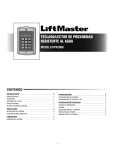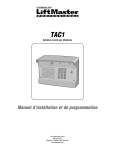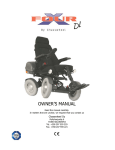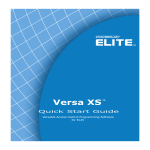Download Chamberlain ELITE EL25 User's Manual
Transcript
® ™ Quickstart EL25 Keypad Programming Guide Telephone entry/access control system with a 25 directory code capacity This Quickstart Guide is intended to highlight some applications. These instructions are not intended to be comprehensive. Please consult the Keypad Programming Manual for complete information. © 2005 The Chamberlain Group, Inc. All Rights Reserved Guide for Programming the EL25 Programming Number *** 0 1 2 3 4 5 6 7 9 10 11 Description of Task Factory Setting Programming Procedure Entering Programming Mode *** (6 Digit Password) Exiting Programming Mode 0# Change or Verify the Unit's Password Set Unit ID Number and No. in Chain 000000 Unit ID 1, Chain No. 1 2 # (unit ID number, 1-7) # (Number of Units in Chain, 1-7) # Set the Clock Enable/Disable Daylight Savings Time Set Visitor Talk Time 1 # (1 to change; 2 to verify) # (six-digit code) # 3 # yymmdd # (day of the week) # hhmm # Enabled 60 Seconds 4 # (0 = disable; 1 = enable) # 5 # (15 – 250 seconds) # Set Directory Code Length 2 Digits 6 # (1 or 2) # Set Entry Code Length 4 Digits 7 # (3-9) # Enable/Disable Call Waiting Enabled 9 # (0 = disable; 1 = enable) # Enable/Disable Do Not Disturb Schedule Disabled 10 # (directory code) # (0 = disable; 1 = enable) # Enable/Disable Unlock Time Zone Enabled 11 # (0 = disable; 1 = enable) # 12 Enable/Disable Anti-Passback Disabled 12 # Enable/Disable True Anti-Passback (0 = disable; 1 = enable) # Enable/Disable Timed Anti-Passback (0 = disable; 1 = enable) # 13 Set Anti-Passback Time 3 Minutes 13 # (1-60 minutes) # 14 Set Maximum Number of Rings Allowed Before Aborting Attempt 15 Set Standard Single Ring or Double Ring Response 16 Number of Rings Before Unit Answers 5 Rings 16 # (0 – 15) # Each unit in chain must have same setting 17 Set “Strikes” and “Out” 3 Errors 17 # (max errors, 0-5) # 18 19 Set Speaker Volume 5 18 # (0 = mute; 1-10, 1 is low and 10 is high) # Set Microphone Volume 5 19 # (0 = mute; 1-10, 1 is low and 10 is high) # 20 21 22 Enable/Disable the Telco Mode Enabled 20 # (0 = disable; 1 = enable) # Enable/Disable Direct Commands Enabled 21 # (0 = disable; 1 enable) # Enable/Disable Voice Mail Disabled 22 # (0 = disable; 1 = enable) # 23 Enable/Disable Access Granted Beeps Enabled 23 # (0 = disable; 1 = enable) # 24 Enable/Disable Real-Time Monitoring Disabled 24 # (0 = disable; 1 = enable) # Optional Steps Indicated with a Important: 5 Rings 0 = One Long Ring 14 # (1 – 9) # 15 # (0 – 1; 0 = one long ring, 1 = double ring) # Background, all other steps are Required The Pound Key (#) must be used as Data Field Separator and to Save Data at the end of the sequence. Time must be entered using a 24-hour format (8AM=0800, 3PM=1500 etc.) 2 Short Beeps: Programming input is valid. 1 Long Beep: Input is not valid. If you make an error during an entry, press the asterisk key ( ) to begin again. * Page 1 Programming Number 28 29 Description of Task Factory Setting Programming Procedure Restore Factory Settings 28 # 101010 # Reset the Unit 29 # 101010 # 30 Create a Time Zone 30 # (time zone number, 2-63) # (segment number; 99) # (starting time = hhmm; 99) # (ending time = hhmm) # (day of week, 1-8; 1 = Sunday; 7 = Saturday; 8 = holiday) # 31 Assign Door Auto Lock/Unlock Time Zone 32 Setting Holidays 32 # (1 = add, 2 = verify, 0 = delete) # (yymmdd; yy = year, mm = month, dd = day of the month) # 40 Add a Basic Directory Code 40 # (directory code) # (phone number) # (phone extension) # 41 Add or Edit a Full Function Directory Code 41 # (directory code) # (phone number) # (phone ext) # (DnD schedule number, 0-63) # (enable/disable call fwd) # (call fwd schedule number, 0-63) # (new call fwd phone number) # (call fwd phone ext) # 44 Change a Directory Code ONLY 44 # (new directory code) # (directory code to change) # 45 Activate/Deactivate a Directory Code 45 # (directory code) # (0 = deactivate; 1 activate) # (0 = don't use start; 1 = use start) # (Start Date = yymmdd) # (Start Time = hhmm) # (0 = don't use end; 1 = use end) # (End Date = yymmdd) # (End Time = hhmm) # 46 Enable/Disable Call Forwarding (Directory Calls) 47 48 Verify a Directory Code 47 # (directory code) # Delete a Directory Code 48 # (directory code) # 49 Enable/Disable Call Forwarding and Do Not Disturb Schedule with Residence “Call” Button Only 49# DnD Enable (1)/Disable (0) # DnD Schedule (063) # Call Forward Enable/Disable (0 = disable; 1 = enable) # Call Forward Schedule (schedule number, 0-63 # (new call forward phone number) # (call forward phone extension) # (call forward extension delay, 0 to 30 sec.) # 50 Add a Basic Entry Code 51 Add/Edit a Full Function Entry Code 54 55 Change an Entry Code ONLY 54 # (entry code to change) # (new entry code) # Verify an Entry Code 55 # (entry code) # Activate/Deactivate an Entry Code 56 # (entry code) # (0 = deactivate; 1 activate) # (0 = don't use start; 1 = use start) # (Start Date = yymmdd) # (Start Time = hhmm) # (0 = don't use end; 1 = use end) # (End Date = yymmdd) # (End Time = hhmm) # 56 Optional Steps Indicated with a Disabled Disabled Disabled 31 # (door 1-4) # (time zone, 2-63; 99) # 46 # (directory code) # (0 = disable; 1 = enable) (schedule number, 0-63) # (new call forward phone number) # (call forward phone extension) # 50 # (entry code) # 51 # (entry code) # (schedule for door 1, 0-63) # (schedule for door 2, 0-63) # (schedule for door 3, 0-63) # (schedule for door 4, 0-63) # Background, all other steps are Required To enter programming mode from the EL25: and the 6-Digit Password (2 short beeps will be heard) Press Exiting programming mode allows changes to take effect *** Page 2 Programming Number 57 Description of Task Factory Setting Delete an Entry Code Programming Procedure 57 # (entry code) # 60 Assign Each External Access Control Device a “Door Number” (Step 1 of 4) No Device Assigned 60 # (device 1-4) # (device type 0-2; 0 = no device, 1 = wiegand card reader or keypad, 2 = RF receiver) # (door 1-4) # 61 D1=Relay 1 D2=Relay 2 D3=Relay 3 D4=Relay 4 61 # (door 1-4) # (relays to activate 0000-1111) # Assign “Each” Door Number to One or More Relays (Step 4 of 4) 63 Assign Door Use Time Zone 64 Set Anti-Passback Entry/Exit for Specific Devices 65 Order of relay is: relay 4 – relay 3 – relay 2 – relay 1 for an example if you want relay 4 active you would enter 1000, if you want relay 1 active you would enter 0001 D1,D2,D3,D4=Enabled 63 # (door 1-4) # (time zone, 0-63) # Disabled 64 # (device 0-4) # (0-3; 0 = disable, 1 = set device to timed anti-passback, 2 = set device to true anti-passback - entrance, 3 = set device for true anti-passback - exit) # Set Each “Relay Type” to get the Appropriate Response (Step 2 of 4) All Relays =“Strike” 65 # (relay 1-4) # (0-5; 0 = unknown, 1 = strike, 2 = shunt, 3 = CCTV, 4 = alarm, 5 = control) # 66 Set Each Relay's “Activation Time” (Step 3 of 4) All Relays = 10 seconds 66 # (relay number 1-4) # (activation time, 1-300 seconds) # 67 Configure an Exit Device (REX) R1=Door 1 R2=Door 2 R3=Door 3 R4=Door 4 67 # (REX number 1-4) # (select REX option: 0 = disabled, 1 = use your door settings or 2 = use specific relay(s) 0000-1111) # Order of Relays are 4321 68 Configure a Door Sensing Device DS1=Door 1 DS2=Door 2 DS3=Door 3 DS4=Door 4 68 # (sensor number 1-4) # (select sensor option: 0 = disabled, 1 = use your door settings or 2 = use specific relay(s) 0000-1111) # Order of Relays are 4321 69 Assign a Postal Lock Switch to Door No. 70 Door 1 69 # (door 0-4; 0 = no postal lock) # Set Relay(s) for AutoCall No Relays Assigned 70 # (relays to activate 0000-1111) # Order of relays are 4321 71 Set the Default Card Type 30-bit Cards 73 Set the Default Facility Code 74 Enable/Ignore Facility Code when Card is Used 80 Add a Basic Card 80 # (card PIN code) # (facility code) # (card type, 26 or 30) # 81 Add or Edit a Full Function Card 81 # (card PIN code) # (facility code) # (card type, 26 or 30) # (schedule for door 1, 0-63) # (schedule for door 2, 0-63) # (schedule for door 3, 0-63) # (schedule for door 4, 0-63) # Add a Card Group 82 # (card PIN code start range) # (card PIN code end range) # (facility code) # (card type, 26 or 30) # (0 = deactivate; 1 = activate) # (schedule for door 1, 0-63) # (schedule for door 2, 0-63) # (schedule for door 3, 0-63) # (schedule for door 4, 0-63) # 82 Optional Steps Indicated with a Important: 0 Ignored 71 # (26 or 30) # 73 # (0-255) # 74 # (0 = disable; 1 = ignore) # Background, all other steps are Required The Pound Key (#) must be used as Data Field Separator and to Save Data at the end of the sequence. Time must be entered using a 24-hour format (8AM=0800, 3PM=1500 etc.) 2 Short Beeps: Programming input is valid. 1 Long Beep: Input is not valid. If you make an error during an entry, press the asterisk key ( ) to begin again. * Page 3 Programming Number Description of Task Factory Setting Programming Procedure 85 Replace a Card 85 # (lost or stolen card PIN code) # (facility code) # (card type, 26 or 30) # (new card PIN) # (new facility code) # (new card type, 26 or 30) # 86 Verify a Card 86 # (card PIN code) # (facility code) # (card type, 26 or 30) 87 Activate or Deactivate a Card 87 # (card PIN code) # (facility code) # (card type, 26 or 30) # (0 = deactivate; 1 = activate) # (0 = don't use start; 1 = use start) # (Start Date = yymmdd) # (Start Time = hhmm) # (0 = don't use end; 1 = use end) # (End Date = yymmdd) # (End Time = hhmm) # 88 Delete a Card 88 # (card PIN code) # (facility code) # (card type, 26 or 30) # 90 Add a Basic Transmitter 90 # (transmitter PIN code) # (facility code) # (sequence number) # (ID number) # (button number) # Add or Edit a Full Function Transmitter 91 # (transmitter PIN code) # (facility code) # (sequence number) # (ID number) # (button number) # (schedule for door 1, 0-63) # (schedule for door 2, 0-63) # (schedule for door 3, 0-63) # (schedule for door 4, 0-63) # Add a Group of Transmitters at Once 94 # (transmitter PIN code start range) # (transmitter PIN code end range) # (facility code) # (sequence number) # (ID number) # (button number) # (0 = deactivate; 1 activate) # (schedule for door 1, 0-63) # (schedule for door 2, 0-63) # (schedule for door 3, 0-63) # (schedule for door 4, 0-63) # 95 Replace a Lost Transmitter 95 # (transmitter PIN to change) # (facility code) # (sequence number) # (ID number) # (button number) # (new transmitter PIN) # (new facility code) # (new sequence number) # (new ID number) # (new button number) # 96 Verify a Transmitter 96 # (transmitter PIN code) # (facility code) # (sequence number) # (ID number) # (button number) # 98 Activate or Deactivate a Transmitter 98 # (transmitter PIN code) # (facility code) # (sequence number) # (ID number) # (button number) # (0 = deactivate; 1 activate) # (0 = don't use start; 1 = use start) #(Start Date = yymmdd) # (Start Time = hhmm) # (0 = don't use end; 1 = use end) #(End Date = yymmdd) # (End Time = hhmm) # 100 Deactivate a Button on a Transmitter and/or Delete a Transmitter 100 # (transmitter PIN code) # (facility code) # (sequence number) # (ID number) # (button number) # 102 Configure “Door Held Open” Alarm Feature 103 Configure “Door Forced Open” Alarm Feature 91 94 Optional Steps Indicated with a Disabled 102 # (alarm option; 0 = disable, 1 = enable until relay time expires, 2 = enable until alarm clears) # (relay group, 0000-1111) # Order of relays is 4321 Disabled 103 # (alarm option; 0 = disable, 1 = enable until relay time expires, 2 = enable until alarm clears) # (relay group, 0000-1111) # Order of relays is 4321 Background, all other steps are Required Page 4 Programming Number Description of Task Factory Setting Programming Procedure 104 Configure “Strikes and Out” Alarm Feature Disabled 104 # (alarm option; 0 = disable, 1 = enable until relay time expires, 2 = enable until alarm clears) # (relay group, 0000-1111) # Order of relays is 4321 105 Enable or Disable Anti-Passback Forgiveness at Midnight Enabled 105 # (0 = disable; 1 = enable) # 109 Override Telephone Company Answering Service 110 Set a Phone Number's Extension Delay Time 111 Verify Multi-Unit Number 113 Dial “0-9” First to Get an Outside Line Using a Automated Phone System Disabled 113 # (0 = disable; 1 = enable) # (0-9, when enabled) # 115 Set Alternative Prefixes Normal 115 # (normal-00, mixed-01, asterisk-02, pound-03, number-1n) # each unit in chain must have same setting 116 Change the Visitor Call Response Keys 9, 5, 3, 7, 2, 1,* 116 # (activate door 1) # (activate door 2) # (activate door 3) # (activate door 4) # (call wait toggle) # (extend talk time) # (hang up and deny access) # 120 121 122 123 124 131 201 202 203 204 205 Talk through the EL25 Speaker 120 # Cycle Door 121 # (door 1-4) # Latch Door “Open” Until... 122 # (door 1-4) # (end time = hhmm) # Latch Door “Closed” Until... 123 # (door 1-4) # (end time = hhmm) # Release Door “Now” 124 # (door 1-4) # Cycle Relay “Now” 131 # (relay 1-4) # Delete ALL Directory Codes 201 # 101010 # Delete ALL Entry Codes 202 # 101010 # Delete ALL Access Cards 203 # 101010 # Delete ALL Transmitter Codes 204 # 101010 # Delete ALL Time Zones 205 # 101010 # Delete ALL Access Codes from Database 206 # 101010 # 206 Optional Steps Indicated with a No No Delay 109 # (0 = no; 1 = yes) # Default is “No” 110 # (directory code) # (phone extension delay) # (call forward extension delay) # 111 # Background, all other steps are Required To enter programming mode from the EL25: and the 6-Digit Password (2 short beeps will be heard) Press Exiting programming mode allows changes to take effect *** Important: The Pound Key (#) must be used as Data Field Separator and to Save Data at the end of the sequence. Time must be entered using a 24-hour format (8AM=0800, 3PM=1500 etc.) 2 Short Beeps: Programming input is valid. 1 Long Beep: Input is not valid. If you make an error during an entry, press the asterisk key ( ) to begin again. * Page 5 Programming Single Unit Overview The EL25 can be programmed 3 different ways. 1 EL25 Keypad: You may use the keypad on the front panel. (Next Page) 2 Local/Remote DTMF Phone: You may use the keypad on a local or remote phone to program the system. The unit responds to the DTMF signals generated by your touch-tone phone. (Next Page) 3 Direct/Modem Connection to a PC: In order to program the EL25 with a direct or modem connection, your PC must be running Sentex's Windows®-compatible Versa XS software. (Not covered in this Quickstart Guide) THIS guide will outline some programming for the EL25 from the keypad or local/remote DTMF (Touch-Tone) phone ONLY. For more information, refer to the Manuals and/or your installation dealer. Procedure Required to Program the EL25: 1 1, 2 or 3 digit # Programming Number. (See “Quick Reference Guide” Tables for descriptions and procedures) 2 One or more Data Fields. 3 Pound Key (#) as a Data Field Separator and at the end of the programming sequence to Save the Data. Notes: • All data fields must be separated with the pound key (#). Example: ( # Programming Number) # (Data Field) # (Data Field) # (Data Field) # 1 Required Step 2 Optional Step 3 Required Step Required Step Optional Step, Press (#) to Skip. 4 Required Step • Steps tagged with a ( ) are optional, press the pound key (#) to skip them. Note: Some steps are required and must have data entered in them to continue, tagged with ( ). • If you make an error during an entry, press the asterisk key (*) to cancel the step. • When you correctly enter the entire programming sequence, the unit will respond with 2 short beeps (see also System Feedback/Responses (Beeps)). Example of a Programming Sequence: “ 1st Pound Key: Separates the 1st field. Pound Key: Separates the data field. 1 Changing the Password” Last Pound Key: Saves the data. Enter Programming Mode (Next page) Programming Number: 1 changes or verifies the password. Exit 2 short beeps Programming Mode (Next page) Data Field: 1 changes the password Data Field: (The new password) (2 verifies the password) If you make an error during an entry, press the asterisk key ( ) to begin again. * Page 6 Programming Single Unit Overview Programming Single Unit Overview Programming Basics Enter Programming Mode *** Important: After entering programming mode for the first time, we suggest you change the password to maintain the security of your system. 1 From the EL25 Keypad: 1 Press 2 Enter the (6) six-digit password. The default is six zeroes. 2 Short Beeps The unit is now ready to accept programming instructions! 2 From the Residence Telephone: 1 When you hear the dial tone, press 1A If multiple EL25 units are sharing the same phone line, then a Unit ID Code (1-7) will need to be entered at this time. 2 Enter the (6) six-digit password. The default is six zeroes. 3 Press and the tone will stop. The unit is now ready to accept programming instructions! 2 From the Remote Telephone: 1 Dial the unit's phone number. Note: If the EL25 and an answering machine (or answering service) utilize the same phone line, let the line ring at least (2) two times, hang-up, and call back within one (1) minute. The EL25 will answer on the second call. If the unit does not answer, you may need to change the ring count. 2 When the EL25 picks up the call, you will hear 2 beeps. 3 Press 3A If multiple EL25 units are sharing the same phone line, then a Unit ID Code (1-7) will need to be entered at this time. 4 Enter the (6) six-digit password. The default is six zeroes. 5 Press and the beeps will stop. The unit is now ready to accept programming instructions! Exit Programming Mode 0 • Press on the EL25 keypad and the unit will respond with 3 short beeps when disconnecting. • Press on the telephone and the unit will respond with 3 short beeps when disconnecting. Press when using a telephone or the EL25 to cancel programming sequence and exit programming mode. Page 7 Programming Single Unit Overview Programming Single Unit Overview If you will be programming the unit via modem, please refer to the Versa XS online help. System Feedback / Responses (Beeps) Programming Responses: 2 Short Beeps: 3 Short Beeps: Programming step was valid. Programming mode was exited. 1 Long Beep: Input was not valid. 2 Long Beeps: Duplicate entry code was entered. 3 Long Beeps: Memory is full. 4 Long Beeps: Unit has reset or is powering up. Busy Signal: Line is busy or Do Not Disturb feature is in effect. Direct Command Responses: 5 Short Beeps: Gate is closing by command. 10 Short Beeps Gate is opening by command. Other Responses: 1 Short Beep: Key was pressed on the unit's keypad. 1 Beep: Talk time for a visitor call is lapsing and the unit will beep once per second for the last 10 seconds unless the talk time is extended. Ring Back: The unit is ringing the building. 10 Short Beeps: The unit has granted access. Silence: The keypad has struck out, the unit is being programmed from another source, or an alarm condition exists. Sending Direct Commands from the Resident's Phone (NPBI / Single Family Residence ONLY) You can send commands directly to the EL25 from your phone without being in programming mode. This feature is only available for a single-family residence or a manager is sharing a phone line with the EL25. To Enter a Direct Command from a Residence Phone: 1 Lift the receiver and press 1A If multiple EL25 units are sharing the same phone line, then a Unit ID Code (1-7) will need to be entered at this time. The unit is now ready to allow direct commands only! Example 1: Example 2: Enters direct command mode Enters direct command mode for unit three Page 8 Programming Single Unit Overview Programming Single Unit Overview The EL25 emits various audio tones to respond to input and to indicate certain conditions. Up to seven (7) EL25s can be installed on a single telephone line. Each unit must have a “Unique Unit ID” number and the “Number of Units in Chain” assigned to it. Set the Unit ID Number and Number of Units in Chain: 2 The unit ID identifies each unit within a chain. Adding or removing EL25s will require the unit ID's to be re-entered. Factory Setting: Unit ID 1 and Number of Units in Chain 1. 1 Press Then Important: This must be performed for EACH unit in the Chain. 2 Unit ID Number (1-7), Then 3 Total Number of Units in Chain (1-7), Then Example: Unique Unit ID Sequencial Order Unit ID “1” Residence Unit ID “2” Unit ID “3” Unit ID “7” Telco Entrance Box Demarcation Point Number of Units in Chain “7” Important: EACH unit in the Chain must have the same “Rings Before Answer”. 16 Factory Setting - 5 Rings EACH unit in the Chain must have the same “Alternate Prefix”. 115 Factory Setting - Normal Verify Unit Number: 111 This allows you to verify a unit's number within a chain. When you perform this step, the unit will respond with the number of beeps corresponding to its unit ID number. Two beeps, for example, mean the unit is number 2 in the chain. Then Note: You cannot program a unit within a multi-unit chain from a local/remote DTMF phone (Touch-Tone) unless you know the unit's ID number. Therefore, you can only verify the unit number while programming from the unit's front keypad. If you make an error during an entry, press the asterisk key ( ) to begin again. * Page 9 Programming Multiple Units Overview Programming Multiple Units Overview Programming Multiple Units Overview EL25 SetUp “Your Settings” The EL25 comes preprogrammed with Factory Settings. When the unit is first installed, you DO NOT need to program each feature. Review the unit's factory settings before programming (see Quick Reference Guide in front for ALL the Factory Settings). Getting Started EL25 SetUp “Your Settings” 1 Change the unit password to prevent any tampering with your system's database. When changing the password, save a copy of it in a secure location. If you lose the password, you will not be able to enter into programming mode. Factory Setting: 000000 (See Page 6) Example: 1 Press Then 1 2 3 Changes the unit's password to “123456”. 2 Change (1) or Verify (2) the Password. Then (#) 3 Enter New Password or Password to Verify (6 Digits). Then (#) Set the Clock 3 An accurate clock is critical to the proper use of schedules, time zones and for accurately reporting transactions. The system will adjust itself to daylight saving time if enabled. 1 Press Then 2 Enter Date (yymmdd). Then (#) 3 Enter Day of week. Then (#) 1 = Sunday, 2 = Monday, 3 = Tuesday, 4 = Wednesday, 5 = Thursday, 6 = Friday, 7 = Saturday 4 Time of Day (hhmm). Then (#) All time must be entered using a 24-hour format (8AM=0800, 3PM=1500 etc.) Year Month Day 24-Hour Time Example: 1 2 3 4 Sets the clock to 1PM, Saturday, January 1st, 2005. Important: We recommend you check the clock after installation. Change the Unit's ID and Chain Number for Multiple Unit Configurations ONLY 2 The Unit ID number identifies each unit within the chain. Setting the “Unit ID” and “Number of Units in the Chain” are required so Versa XS can send or receive data to/from the correct units within the chain. Factory Setting: Unit ID Number “1” and Number of Units in Chain “1”. (See Previous Page) If you make an error during an entry, press the asterisk key ( ) to begin again. * Page 10 EL25 SetUp “Your Settings” Change the Unit Password Setup External Access Control Devices What is a Door Number? A Number (1-4) YOU assign to the EL25 unit to Identify the External Access Control Devices wired to it. Up to 4 devices can be connected. Once identified, the unit will keep the Same Door Numbers in other programming. The Internal Keypad is ALWAYS Assigned to Door Number 1. What is a Relay? A relay is a device that reacts to an electric current to activate other devices. Allowing the EL25 to lock or unlock a door/gate, shunt (bypass) alarm contacts, signal an alarm, or turn on a camera wired to a closed-circuit television (CCTV). The relays can be programmed to 5 different modes. The 5 Modes of Operation are: Strike Relay: A Strike Relay controls a door or gate by unlocking or opening it. It does not control any other component associated with a system like Alarms, CCTV, etc. Shunt Relay: A Shunt Relay is normally wired to an alarm and works with strike relays to shunt (bypass) the alarm when the door is opened with a valid access code. If the door is forced open, the system will not shunt the alarm and the alarm will be triggered. CCTV Relay: A CCTV Relay activates the system's optional camera. The camera is wired to a closed circuit television (CCTV). A camera can be activated when an alarm condition occurs or when a resident enters a valid access code. Alarm Relay: The Alarm Relay will activate another device, such as a siren, when 3 conditions occur. A door is opened without a valid access code, A door is open past the allotted time programmed in, or too many invalid codes are tried. Any of these will trigger the alarm relay. Control Relay: The Control Relay can control another device such as an outdoor or indoor light near the unit. For example, you could configure the system to turn on an entry light through a darkened area after a resident enters a valid access code. Then the light would then turn off after a specified amount of time. Page 11 EL25 SetUp “Your Settings” EL25 SetUp “Your Settings” The EL25 must have all external access control device options configured into it, before many of the other programming options can proceed. You must tell the unit “what it's wired to” and “how you want the devices to behave.” To do this you must know what a “Door” Number is and what a “Relay” is. Configuring “YOUR” EL25 There are 3 sample configurations on page 14-16 to help you understand the 4 step process needed to setup YOUR external access control devices. Step 1 Assign Each External Access Control Device to a Door Number: When a valid access code is entered into a external access control device, the Assigned door's relays will activate (See Below). Step 2 Set Each Relay Mode for the Appropriate Response: There are 5 different relay modes (Previous Page). Step 3 Set Each Relay's Activation Time: The relay time determines the amount of time the relay remains activated. For example, when a strike relay activates to unlock a door, the relay activation time determines how long the door will remain unlocked. (Next Page) Step 4 Assign Each Door Number to One or More Relays: Defines which relays will activate when a resident presents a valid access code to an external access control device. (Next Page) Step 1 Assign Each External Access Control Device a “Door Number”: 60 To perform these 4 steps you MUST know EXACTLY where the External Access Control Device(s) were wired in “Your” EL25! When the table on page 14 is completed by you or your installer, this will help you understand “Your” personal layout. If you do not know this, DO NOT PROCEED. Consult your Installer and/or refer to the installation manual for assistance. The EL25 can be equipped with Wiegand reader and radio frequency (RF) modules that allow your system to accommodate external access control devices such as a Wiegand-compatible card reader (keypad) and RF receiver. In order for the devices to work successfully, you must assign them a “Door Number”. When a valid access code is presented to the device, the Assigned Door's Relays will activate. Factory Setting: EL25 Keypad Always Assigned to Door 1, No Devices Assigned - 0 1 Press 4 1 Important: Allthroughepsmust be performed for EACH external access control device of unit. Then 2 Enter External Access Control Device Number (1-4). Then (#) Internal Keypad is ALWAYS Assigned to External Access Control Device Number 0 3 Enter External Access Control Device Type (0-2). Then (#) 0 = Not Activated/No Device Assigned 1 = (Wiegand) Card Reader or Keypad Only 2 = RF Receiver Note: A “Door Number” is a number you assign to each external access control device. 4 Assign a Door Number (1-4) to the Device. Then (#) Example A: 1 2 3 4 Device “1” is a Radio Receiver and Assigned as Door “3”. Example B: 1 2 3 4 Device “3” is a Card Reader or Keypad and Assigned as Door “4”. Page 12 EL25 SetUp “Your Settings” EL25 SetUp “Your Settings” The relay mode determines what the relay will control (a door, alarm, CCTV, etc.). (Next Page) Step 2 Set Each “Relay Mode” to get the Appropriate Response: 65 There are 5 different relay modes. The Relay Mode determines what the response will be when a valid access code is entered (open a door, turn on an alarm, turn on a light then turn it off, turn on a CCTV, etc.). Factory Setting: All Relays are Set at “1 - Strike” 1 Press 3 1 Important: Allthroughepsmust be performed for EACH Relay assigned to the unit. Then 3 Enter Relay Mode (0-5). Then (#) 0 = Not Used 3 = CCTV - activates system's optional camera. 4 = Alarm - activates another device (siren). 1 = Strike - controls a door/gate by unlocking/opening it. 2 = Shunt - bypasses the alarm under normal circumstances. 5 = Control - controls another device (on/off light). Example: 1 2 3 Assigns Relay “2” as a Shunt Relay Step 3 Set Each Relay's “Activation Time”: 66 This is the amount of time (in seconds) the relay remains activated. This will define the amount of time a door cycles (unlocks, then relocks) or how long the CCTV camera remains on after being activated. Factory Setting: All Relays are set at 10 seconds 1 Press 3 1 Important: Allthroughepsmust be performed for EACH Relay assigned to the unit. Then 2 Enter the Relay Number (1-4). Then (#) 3 Enter Activation Time (1-300 Seconds). Then (#) Example: 1 2 3 When Activated, the Relay Number “4” will activate for “30” seconds. Note: A relay that controls a gate operator must be set to activate for 2 seconds. Step 4 Assign “Each” Door Number to One or More Relays: 61 When a valid access code is used at an external access control device (Door), the EL25 can be set to activate one or more relays. Factory Settings: Door 1 Activates Relay 1; Door 2 Activates Relay 2; Door 3 Activates Relay 3; Door 4 Activates Relay 4 1 Press Then 3 1 Important: Allthroughepsmust be performed for EACH Door Number assigned to the unit. 2 Enter Door Number (1-4). Then (#) 3 Enter Relays to be Activated (0000-1111). Then (#) 0 = Deactivate , 1 = Activate (1st digit=Relay 4, 2nd digit=Relay 3, etc.) Relay 4 Relay 3 Relay 2 Relay 1 Example: 1 2 Deact Deact Activate Activate 3 When a Resident uses a Valid Code at “Door 1”, Relay “1” and Relay “2” will Activate. Page 13 EL25 SetUp “Your Settings” EL25 SetUp “Your Settings” 2 Enter the Relay Number (1-4). Then (#) “Your” Door Settings Location Door No. Relay Relay Mode Relay Function Relay Activation Time (Seconds) When “Your Door Settings” or “Door 1,2,3 or 4” are referenced throughout this guide, this completed chart will outline how your EL25 system will function. Sample: EL25 Controlling 1 Door (Page 16) Device Location Door No. Main Keypad Front Door Door 1 (REX) Exit Request Relay Relay Mode Relay Function Relay Activation Time (Seconds) Unlocks Door Bypasses/Signals Alarm 10 sec. 40 sec. Alarm Sounds a Siren 10 sec. CCTV Activates Camera 10 sec. 1 2 Strike Shunt 3 4 Sample: EL25 Controlling 2 Doors and a Vehicle Gate (Page 16) Device Location Main Keypad and Postal Lock Security Light Front Door Wiegand Card Reader Transmitter Back Door Gate Operator Door No. Relay Relay Mode Relay Function Relay Activation Time (Seconds) Door 1 1 2 Strike Control Unlocks Door Turns on Security light 10 sec. 60 sec. Door 2 3 Strike Unlocks Door 10 sec. Door 3 4 Strike Opens Gate 10 sec. Sample: EL25 Controlling 4 Doors (Page 17) Device Location Door No. Main Keypad Wiegand Keypad Front Door (Entrance) Front Door (Exit) Door 1 Wiegand Card Reader Wiegand Card Reader Manager’s Door Back Door Door 2 Door 3 Door 4 Relay Relay Mode Relay Function Relay Activation Time (Seconds) 1 2 Strike Strike Unlocks Door Unlocks Door 10 sec. 10 sec. 3 Strike Unlocks Door 10 sec. 4 Strike Unlocks Door 10 sec. Sample: EL25 Controlling Single Family Residence (Page 18) Device Location Main Keypad and (REX) Exit Request Driveway Wiegand Card Reader CCTV Pedestrian Gate In EL25 Door No. Relay Function Relay Activation Time (Seconds) 1 Strike Opens Vehicular Gate 10 sec. 2 Control Turns on Security Light 10 sec. Door 2 3 Strike Unlocks Pedestrian Gate 10 sec. Door 3 4 CCTV Activates Camera 10 sec. Relay Function Relay Activation Time (Seconds) Unlocks Door Unlocks Door 10 sec. 10 sec. Door 1 Relay Relay Mode Sample: EL25 Controlling Multi-Resident Apartment (Page 19) Device Location Door No. Main Keypad Transmitter and REX Exit Device Front Door (Entrance) Vehicular Gate Door 1 Wiegand Card Reader Siren Front Door (Entrance) Pool Gate Door 2 Door 3 Door 4 Relay Relay Mode 1 2 Strike Strike 3 Strike Unlocks Door 10 sec. 4 Shunt Bypasses/Signals Alarm 30 sec. Page 14 EL25 SetUp “Your Settings” EL25 SetUp “Your Settings” Device (See Tables below for reference) Your System Layout Door Stat 1 Connection Door Sensor and/or Exit Device EL25 SetUp “Your Settings” EL25 SetUp “Your Settings” How your system has been wired is an important part of programming it. Write down your configuration. To help visualize it, draw a map of it below. If you're unsure of your setup, consult your dealer/installer for more information. External Access Control Device(s) connected to aux board(s) Device 0 (Default Internal Keypad) Device 1 Door Stat 2 Connection Door Sensor and/or Exit Device Device 2 Device 3 Device 4 Door Stat 3 Connection Door Sensor and/or Exit Device Relay Connections Door Sensor and/or Exit Device Yes No Postal Lock Yes No CCTV Camera Yes No Relay 1 Relay 2 Door Stat 4 Connection Autocall Device Relay 3 Relay 4 Page 15 EL25 Controlling 1 Door Relay 1 - Strike Mode Unlocks Door for 10 sec. Relay 2 - Shunt Mode Bypasses/Signals Alarm for Maglock for 40 sec. Relay 4 - CCTV Mode Activates Camera for 10 sec. REX Device (Exit) EL25 Main Keypad (Front Door) Device Location Door No. Main Keypad Front Door Door 1 (REX) Exit Request Relay Relay Mode Relay Function Relay Activation Time (Seconds) Unlocks Door Bypasses/Signals Alarm 10 sec. 40 sec. Alarm Sounds a Siren 10 sec. CCTV Activates Camera 10 sec. 1 2 Strike Shunt 3 4 EL25 Controlling 2 Doors and Vehicle Gate Card Reader (Back Door) Relay 3 - Strike Mode Unlocks Door for 10 sec. Relay 2 - Control Mode Turns on Security Light for 60 sec. Relay 1 - Strike Mode Unlocks Door for 10 sec. EL25 Main Keypad (Front Door) Postal Lock Transmitter (Gate Operator) Device Location Main Keypad and Postal Lock Security Light Front Door Wiegand Card Reader Transmitter Back Door Gate Operator Door No. Relay Relay Mode Relay 4 - Strike Mode Opens Gate for 10 sec. Relay Function Relay Activation Time (Seconds) Door 1 1 2 Strike Control Unlocks Door Turns on Security light 10 sec. 60 sec. Door 2 3 Strike Unlocks Door 10 sec. Door 3 4 Strike Opens Gate 10 sec. Page 16 EL25 SetUp “Your Settings” EL25 SetUp “Your Settings” Relay 3 - Alarm Mode Sounds Siren for 10 sec. EL25 Controlling 4 Doors Relay 3 - Strike Mode Unlocks Door for 10 sec. Card Reader (Manager's Door) Relay 4 - Strike Mode Unlocks Door for 10 sec. Relay 2 - Strike Mode Unlocks Door for 10 sec. Wiegand Keypad (Exit) Enter Exit EL25 Main Keypad (Front Door) Relay 1 - Strike Mode Unlocks Door for 10 sec. Device Location Door No. Main Keypad Wiegand Keypad Front Door (Entrance) Front Door (Exit) Door 1 Wiegand Card Reader Wiegand Card Reader Back Door Manager’s Door Door 2 Door 3 Door 4 Relay Relay Mode Relay Function Relay Activation Time (Seconds) 1 2 Strike Strike Unlocks Door Unlocks Door 10 sec. 10 sec. 3 Strike Unlocks Door 10 sec. 4 Strike Unlocks Door 10 sec. Page 17 EL25 SetUp “Your Settings” EL25 SetUp “Your Settings” Card Reader (Back Door) Single Family Residence Car Exit Sensor Relay 3 - Unlocks Pedestrian Gate Relay 1 - Opens Vehicular Gate Gate Operator (Vehicular Gate) Card Reader (Pedestrian Gate) Relay 2 - Turns on Light EL25 with optional CCTV Camera is always on. Device Main Keypad and (REX) Exit Request Wiegand Card Reader CCTV Location Driveway Door No. Door 1 Relay Relay Mode Relay Function Relay Activation Time (Seconds) 1 Strike Opens Vehicular Gate 10 sec. 2 Control Turns on Security Light 10 sec. Pedestrian Gate Door 2 3 Strike Unlocks Pedestrian Gate 10 sec. In EL25 Door 3 4 CCTV Activates Camera 10 sec. Page 18 EL25 SetUp “Your Settings” EL25 SetUp “Your Settings” This EL25 can operate the vehicular gate with an access code or by remote control. It will allow Pedestrians entry with an Access Card. It will also open the gate automatically for exiting cars. Multi-Resident Complex This EL25 can control the property with a vehicular gate operator, access card or the unit's keypad. Residents can use programmed transmitters for the parking lot, access cards for the pool or a personal entry code for the main entrance. The main entrance is equipped with a door sensor to alert management about inappropriate use. The exit sensor will automatically open the gate for exiting cars. Card Reader Relay 3 Opens Pool Gate Card Reader (Pool Gate) Parking Lot Manager's Office Car Exit Sensor Relay 4 - Shunts Alarm for Main Entrance Gate Operator (Vehicular Gate) Internal Keypad Relay 1 Opens Main Entrance EL25 (Main Entrance) RF Receiver Relay 2 Opens Vehicular Gate Device Location Door No. Main Keypad Transmitter and REX Exit Device Front Door (Entrance) Vehicular Gate Door 1 Wiegand Card Reader Siren Pool Gate Front Door (Entrance) Door 2 Door 3 Door 4 Relay Relay Mode 1 2 Strike Strike Relay Function Relay Activation Time (Seconds) Unlocks Door Unlocks Door 10 sec. 10 sec. 3 Strike Unlocks Door 10 sec. 4 Shunt Bypasses/Signals Alarm 30 sec. Page 19 EL25 SetUp “Your Settings” EL25 SetUp “Your Settings” Pool Entry Codes When adding entry codes, note the following: Each assigned Entry Code must be entered with the set amount of allowable digits (3-9). For example, if you assign “4578” as a resident's Entry Code, but the system is set for 5 digits, the visitor will have to enter “04578” to enter the building. 50 Add an Entry Code ONLY. For adding or editing full function Entry Codes (i.e., codes with additional options such as use schedules, door assignments, etc.). 1 Press Then 2 Enter Entry Code (3-9 digits). Then (#) Note: Factory Setting for Entry Code Length is 4 digits See “Entry Code Length” above. Example: 1 2 Adds Entry Code “5400”. Note: A basic Entry Code will be active with the current date, time and never deactivates, unlock all controlled doors, with no time constraint (i.e., can be used 24 hours a day, 7 days a week). If you make an error during an entry, press the asterisk key ( ) to begin again. * Access Cards When adding cards, note the following: • If you don't add a facility code or card type, the system will assign the default. The allowable facility code range is 0-255 for 26-bit cards and 0-63 for 30-bit cards. • When entering cards with facility codes: – Enter the facility codes individually when adding cards OR – Enter a default facility code. If you don't, the card will be assigned the default facility code. Add a Basic Card: 80 This programming step allows you to add a card using the card's number. For adding or editing full function cards (i.e., cards with additional options such as use schedules, door assignments, etc.). Then 1 Press Required Step Optional Step, Press (#) to Skip. 2 Enter Card Number (1-65534). Then (#) 3 Enter Facility Code (0-63 or 0-255, depending on the card type). Then (#) 4 Enter Card Type (26 or 30). Then (#) Example: 1 2 3 4 Adds card with number “34432”, default Facility Code and 30-bit Card Type. Notes: A basic card will be active with the current system time and never deactivate, unlock all doors connected to the EL25, with no time constraint (i.e., can be used 24 hours a day, 7 days a week). For new records, if you don't add a Facility Code or Card Type, the system will add the defined default values. Page 20 Entry Codes / Access Cards Entry Codes / Access Cards Add a Basic Entry Code: Transmitters When adding transmitter codes, note the following: • The label on the back of the transmitter displays the codes necessary to program the transmitter. ID Number Button Number PASSPORT SW ID SEQ FC PIN 1-3 03 00 034 12241 4 03 00 163 45009 • To activate more than one button on a transmitter, you must repeat all steps for each button. If you want to activate four buttons of a new transmitter, you will need to perform the Program Number fourfour times, 90 activating each button separately. Add a Basic Transmitter: 90 Add a Basic transmitter to the system's database. A basic transmitter will be active, unlock all doors/gates assigned to the RF module with no time constraints (i.e., can be used 24 hours a day, 7 days a week.). 1 Press Then 4 Enter Sequence Code (0-2). Then (#) 2 Enter Transmitter Number (1-65534). Then (#) 5 Enter ID Number (0-26). Then (#) 3 Enter Facility Code (0-255). Then (#) 6 Enter Button Number (1-4). Then (#) 6 1 Important: Allthroughepsmust be performed for EACH Transmitter assigned. Example: 1 2 3 4 5 6 Activates transmitter number “34430”, facility code “3”, sequence code “2”, ID number “4” and button “1”. If you make an error during an entry, press the asterisk key ( ) to begin again. * Page 21 Transmitters Transmitters Codes for Buttons 1-3 Codes for Button 4 Sequence Code Facility Code Transmitter Number A Access Device (RF Receiver, Card Reader, or Keypad) - A device that reads transmitter, card or entry codes, allowing the system to allow or reject entry based on the code's validity. Access Codes - Codes that enable visitors and residents to enter a building through a controlled area. Access codes include directory codes, entry codes, cards and transmitters. An access code is associated with a specific access device. Directory codes are associated with the EL25 unit; entry codes with the unit keypad; cards with card readers; and transmitters with radio frequency (RF) receivers. Alarms - The EL25 unit may be configured to trigger an alarm (e.g., Activate a siren and/or a warning light, etc.) when an alarm condition occurs. These conditions include a door held open too long, a door forced open, or keypad errors that exceed the maximum allowed. Anti-Passback - The Anti-Passback feature prevents unauthorized use of entry codes, cards, and transmitters. When anti-passback is enabled, an access code will be temporarily disabled after each use, thereby prohibiting people from “passing back” their access code, card, or transmitter to unauthorized people. B Button Number - Refers to the number assigned to each button on a multi-button transmitter. Up to 4 buttons per remote. C Call Forwarding - The EL25 can be programmed to “forward” a visitor call to another location when residents are away. This feature also allows you to grant access to a visitor from a remote location. Call Forward Control Setting - When enabled, allows the unit to use Call Forwarding with schedules. Call Waiting (NPBI / Single Family Residence) - If the resident's phone is in use when the visitor presses the “Call” key, they will hear 2 short tones to signal that a visitor is attempting to call. They may simply switch over to the call from the visitor, let him/her in, and go back to the original call. This feature is only available for a single-family residence or a manager's phone sharing a phone line with the EL25. Card Type - 26-Bit standard or 30-Bit. Credential - A card, PIN or Biometric . D Direct Commands (NPBI / Single Family Residence) - You may send a direct command from your residence phone to activate one of four relays (i.e., to open a door). This feature is only available for a single-family residence or a manager's phone sharing a phone line with the EL25 unit. Directory Code - Unique 1-2 digit codes that dial a corresponding telephone number in the building. The unit will dial the phone number assigned to the code. Do Not Disturb (DnD) - The EL25 has the ability to block visitor calls during specific times. Using schedules, the feature activates and deactivates automatically. DnD Control Setting - When enabled the unit will enforce DnD schedule, if disabled the unit will ignore DnD schedule. DTMF phone - Dual Tone Multi Frequency (Touch-Tone Phone). E Entry Card - A resident presents an entry card to a card reader to gain entry into a controlled area. A card's PIN, or “Personal Identification Number”, is a part of the encoded information that makes a card unique. Entry Code - Programmable, numeric codes (3-9 digits in length) that allow entry or exit through a gate/door. Residents enter their assigned entry code onto the unit's keypad to prompt the system to grant access. F Facility Code - A code that allows access cards/transmitters to be associated with a facility or complex. This allows you to manage more than one complex. You may also assign a default facility code if a group of access cards/transmitters will share the same code. Continued on next page Page 22 Glossary Glossary Glossary Glossary Gate or Door - Used synonymously throughout the manual, these terms refer to controllable entry/exit areas of the G complex, normally a gate or door. H Holiday Schedules - Holiday schedules will modify fixed schedules for selected holiday dates. I ID Number - One part of the number sequence on a transmitter. M Manager - This person manages a complex and/or programs the system. NPBI system - No Phone Bill Interface. Uses main phone line like a intercom system between EL25 and the resident P PBX - A PBX telephone system (Automated) needs to dial a specific number (0-9) then pause briefly, allowing the PBX system to connect to an outside phone line, then the phone number can be dialed. PIN Code - Personal Identification Number predefined for a HID card or Transmitter. Programming Number - This is a number that the EL25 uses to program a function. Each number performs a specific task. R Radio Frequency (RF) and Wiegand Module - Each RF module is an RF receiver that is compatible with Chamberlain Passport™ transmitters. Each Wiegand module provides Wiegand inputs for two card readers or other compatible devices. Relay - A device that responds to an electric current by activating other devices, allowing the system, for example, to lock or unlock a door/gate, shunt (i.e., reroute) alarm contacts, signal an alarm, or turn on a camera that transmits its images to a closed circuited television (CCTV). Resident - Person occupying and/or who has entry access to the building or complex that is controlled by a EL25 unit. The term “resident” as used in the context of the manual refers to such persons as homeowners, tenants of an apartment complex, etc. Schedules - You can restrict the use of access codes/transmitters by setting limits on the days and times they may be S used. Schedules may also be assigned to doors to restrict residents from gaining access to the building. Sequence Code - One part of the number sequence of a transmitter. T Telco Mode - Uses the main telephone line for the unit's communications to a house or complex. Transaction - System activity logged and recorded into the EL25's memory. Such activity includes visitor to resident directory calls and transmitter, card, or code activity. Transmitter - A resident-activated clicker device used to gain entry into a controlled area. Unit - The unit houses the EL25's core components. All system programming will be routed to the EL25. U Unit ID Code - Identification number for each unit in a multiple unit setup sharing the same phone line. Versa XS - The software to program the EL25 with. V Visitor - A visitor can communicate with residents via the EL25. A resident can grant or deny a visitor access with their touch tone phone. Page 23 Glossary Glossary N phone. No monthly or per call telephone charges. Appendix Access Cards Page 20 Direct Commands Page 8 Page 20 Programming – Enter Program Mode – Exit Program Mode – Multiple Units – Single Unit Quick Reference Guide System – Clock – Feedback/Responses – Password – Unit’s ID Page 7 Page 7 Page 9 Page 6 Pages 1-5 Page 10 Page 8 Page 10 Page 10 Setup – Doors – Relays Pages 12-19 Pages 11-13 Transmitters Page 21 Glossary Pages 22-23 Page 24 Appendix Appendix Entry Codes ® ™ 845 Larch Avenue Elmhurst, Illinois 60125-1196 114A3042 © 2005 The Chamberlain Group, Inc. All Rights Reserved


























